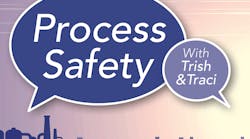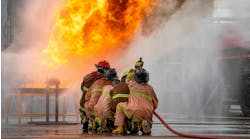Podcast: Preventable Patterns Revealed In 2021 Process Safety Incidents
A review of 2021’s process-safety incidents points out that there's nothing new in any of these events; there's no new technology pathway, there's no new chemical reaction or law of chemistry or physics. That means these are all preventable incidents. What are you doing at your facilities to understand these hazards?
Transcription:
Traci: Welcome to "Process Safety With Trish & Traci," the podcast that aims to share insights from past incidents to help avoid future events. I'm Traci Purdum, executive digital editor with Chemical Processing, and as always, I'm joined by Trish Kerin, the director of the IChemE Safety Centre. Hey, Trish, how are you?
Trish: I'm doing well. Thanks, Traci. How are you doing?
Traci: I'm doing fine. But can you believe that another year has passed?
Trish: I know, we're coming up to that time of the year when we all sort of stop, and take stock, and start to think about what our new year's resolutions might be, perhaps, but also, you know, there's still a few weeks to get to that point. We need to make sure we remain safe between now and then.
Traci: Indeed. And as we close out 2021, I thought it would be a good idea to review some of the process safety incidents that have occurred this year, and see if there are any lessons learned that can help others avoid, or at least be aware of in the future. And you and I went through... You know, there's about six or seven, maybe eight incidents that happened this year. So we're going to go through those, and hopefully, you can give us some insight on lessons learned from each one, and your thoughts on what's happening. So, sound good to you?
Trish: Sounds great. Let's do it.
Traci: All right. Well, in January... I'm going to go chronologically. In January a liquid nitrogen leak at the Foundation Food Group poultry plant in Gainesville, Georgia, killed six people and hospitalized at least seven others. What do you know, and what has been learned from this incident?
Trish: Now, this incident is under investigation by the CSB, and we've seen a couple of factual updates provided to us at that point so far, but the investigation's still underway. So we don't know precisely what the root cause was yet. What we do know, though, is there was maintenance occurring on the line where they had the leak of liquid nitrogen occur. So, I want you to keep maintenance in your mind as a potential issue here as we go through some of these other incidents as well because, obviously, we were interfering with the system in some way as we do in a maintenance activity, and that can sometimes lead to hazards being introduced, in this instance, the potential for the liquid nitrogen to be released, which overcame the workers in the area.
Traci: All right. The next incident we have on the docket is, it happened in March, and five workers were injured and hundreds evacuated after a massive blaze at West Java oil refinery in Indonesia. Can you give us some insight there?
No worries! Subscribe and listen whenever, wherever.
Traci: All right, moving on to April, an explosion occurred at the Yenkin-Majestic paints plant in Columbus, Ohio. The fire chief was quoted as saying “it was kind of like they were involved in a car accident. We had to use special tools to pry them out.” Unfortunately, one worker did die. What can be learned from this tragedy?
Trish: So again, see if they are investigating this one. And there's been a couple of factual updates, still not a lot of information available yet. There does appear to have been a loss of containment during the resin manufacturing process. Now we're talking about batch processing. There was a series of different processing kettles that was using, I believe, gas-fired heaters to heat up what was going on in those kettles to manufacture the coatings. So, one of the things we need to think about is how we do process control. And so, I would question how the process control was happening in that particular facility at the time around the batching process, what was going on, that then potentially led to the loss of containment. It could have been an overpressurization, for example, but we don't know that yet. So the whole idea of how we're maintaining our process control and our operating envelope, I think, is important to keep in mind.
Traci: Another incident that happened in April, a large fire at Manor Chemical in St. Louis, Missouri, injured a firefighter. We have talked in the past about the importance of keeping first responders informed. What are the takeaways from this event?
[pullquote]
Trish: Again, this one, there's not a lot of great information available at the moment on this one, but it does appear as though there was a lot of flammable chemicals stored at this facility. And so, when we have a range of different chemicals stored, and we have an incident occur, our first responders need to know precisely what's on-site because they need to know what's going to happen next. If they know what chemicals are on-site, then they can figure out what is going to react with what. Are we going to have chemicals on-site that potentially react violently with water? That's a big problem if you're trying to fight a fire in a traditional method. So those sorts of things are really important to make sure that our emergency responders know what's happening first before they walk on the site to start fighting the fire or the incident. So we need good quality manifest, that information needs to be communicated to them, and they then need to have adequate training to be able to respond to what's in front of them.
Traci: All right. In July we had an incident, there was a fatal chemical release at the LyondellBasell facility in La Porte, Texas. Two employees died, and plant workers have severe injuries that they're continuing to feel the effects of, along with the anguish of a mass casualty event. Can you talk a little bit about this incident?
Trish: So again, this one's under investigation by the CSB, a couple of factual updates, but still no great details coming out about what caused the release that occurred. There is a possibility that there was... It had stated that it was around a maintenance event. So again, we're back to this idea of maintenance events, and what we are doing, how we're preparing our equipment to undertake maintenance in a safe manner. We are looking at a release here. Did we have a failure of isolation, or did we have an inadvertent breaking into a live system rather than a system that was down for maintenance? I don't know yet. We haven't seen the facts on that, but how we prepare for maintenance, and how we do our risk identification processes so that we know precisely what is around us, and how can then operate safely in that instance is critically important. So I'd suggest, there's probably some things here around risk identification, as we prepare for maintenance, and making sure that we have adequate isolations.
Traci: On the other side of the world, in Germany, on that same day as that event, there was an explosion at a Chempark waste incineration site. One worker was killed and others injured. Three tanks at the site were completely or partially destroyed, making it hard to determine where the explosion happened. What can we learn from this incident?
Trish: So this one is around, again, really understanding precisely the nature of the products you have on your site. So, for example, it was a waste chemical site. So presumably, they receive all sorts of different chemicals from all sorts of different places, and they then dispose of them by incineration. Was there a reaction that took place potentially because we still don't have the facts of this one yet, either? But if the wrong chemical was put into a tank, you could cause a runaway reaction, which could then result in overpressurization explosion fire that has then resulted in the rest of the damage that's occurred. So when we send our waste products away, we need to make sure that we tell the waste receiver precisely what we're sending them. And likewise, the waste receivers need to make sure they understand they may need to test some chemicals as they come in to determine how they can safely be stored until they're destroyed.
Traci: All right, moving on to August, there was a fire at a Pemex offshore oil platform that resulted in the deaths of five workers in Mexico. The incident came six weeks after a gas leak in an underwater Pemex pipeline triggered a fire on the ocean surface in the Gulf of Mexico. Were warning signs ignored on this one?
Trish: Look, that's hard to know. We still don't have the facts of this one, either. Again, there was maintenance activity occurring on the platform at the time. So how are we controlling our hazards as we go in and plan, and undertake maintenance activities? These are things like our permit to work processes, our task-based risk assessments, making sure if we're doing any changes to any part of the equipment, that we've done a complete management of change, and assessed the hazards and risks of that as well. So we really need to focus on making sure that maintenance is planned properly and thoroughly, and then undertaken thoroughly through the plan. If something changes, the plan has to be revived and reviewed again.
Traci: Now, our most recent incident that we're going to discuss today, and the final one is a November fire at Bridgewood plastics in the UK. It was deemed an accident, explosions from the fire fueled about 300 tons of rigid plastic, and shook nearby buildings. The fire chief said that the speed with which the company had reacted to the fire helped to ensure nobody was injured. Accident seems a bit nonchalant. What are your thoughts on this one?
Trish: Yes, I have to admit, I read this one and thought, "Oh, I don't like that." What I don't like about it is, if a simple accident, oops, something went wrong results in 300 tons of plastic burning, and a shelter-in-place of some 5 miles, I think it was, you've got a big problem. So we can't just accept that accidents like that happen. We really need to understand precisely what the systemic issues were at the facility that allowed...if it was a human error that led to it, that allowed that human error to end in such a catastrophic manner. Fortunately, their emergency response did work and there was no one killed in this instance, which was fantastic, but there was still a lot of environmental pollution into the air, a lot of disruption because of the smoke plume and the shelter-in-place. So, the idea that we can write something off as an accident worries me. We should never ever be doing that in the world of process safety. We need to understand precisely what it is that's causing the incident, and what are the systems and context around that so that we can then take positive action with our workforce to make sure that we make the system as user-friendly as possible for them. It's easier to get it right than to get it wrong.
Traci: Now, these are all different events, different places in the world, but there are themes, obviously, you're pulling out these themes. Can you talk a little bit about the common denominator in some of these?
Trish: Yeah. Whilst they are all different incidents that happened all over the world, they're all same, same, but different. At the end of the day, there is nothing new in any of these incidents. There's no new technology pathway, there's no new chemical reaction or law of chemistry or physics that have changed that resulted in this. Now that means, these are all preventable incidents because we actually have the science and technology background to be able to prevent them. But for some reason, we haven't learned that, and the incident has occurred. I think for me, it's around really trying to understand, why aren't we learning? And there are some key themes, as you said, that repeated as I went through and study these incidents, even though we don't have definitive courses, there's some themes I can kind of infer and pull out from them a little bit.
First of all, maintenance. Maintenance preparation and maintenance activity. If we don't get our maintenance preparation and our activity done properly, then we're opening ourselves up to the potential of a catastrophic incident when we're talking process safety and hazardous chemicals. Do our isolations work? Do we know they actually hold and are working, or are we relying on a single valve isolation, and there's something hazardous on the other side of that valve? And guess what? That valve leaks. Because guess what? Every valve has the potential to leak. We need to make sure that we are not relying just only on single isolations. We need to make sure that we are also positively testing isolation so that we don't end up in a situation where we have leakage of a flammable substance or a toxic substance into an atmosphere where it could either harm humans, the environment, or result in an ignition source of some sort causing an explosion.
So, there's the isolation part, but then there's the actual maintenance part. When we go to do maintenance and we've isolated, and we go to work on a particular piece of equipment, are we working on the right piece of equipment? There's been more than one incident in the past where, inadvertently, because of a range of systemic issues, the maintainer has turned up to the wrong piece of equipment, and done something to it that has resulted in an incident occurring. So, we need to make sure that we've got positive identification of the right equipment at the right time to do the work. Another theme that I pulled out of these is, obviously, there's a series of losses of containment that occurred in here. Now, losses of containment, they do happen. We have leaks. We need to make sure that we don't have leaks, or we minimize them.
And we minimize the volume of them. Once we've had that loss of containment, it can then go one of two ways. It can just be a loss of containment, which is a problem in itself, or we can have an ignition source occur at the same time. When we have the ignition source occur, then we're more likely to have that explosion, that fire occur, and that's where we see widespread damage, human impact at the same time. So, we always need to make sure we are controlling our ignition sources because when I was working in a refinery, we always used to say that almost, you know, the vapor has a mind of its own, and it goes seeking the ignition source. It's as if the flammable vapor goes looking for that ignition source, just to find so it can ignite, make sure it can't find an ignition source.
We've got to do both. We've got to stop the loss of containment, and we've got to make sure we control those ignition sources, because if you have a loss of containment, it's going to find an ignition source somewhere. And at that point in time, you've got the ignition, the explosion, the fire, the damage, the human impact as well. Process control and batching sort of stood out to me as well. There's a few instances here where they have batching-type operations. So when you've got that batching-type operation, you've got the situation of you're always going through a startup, and then a shutdown because you're batching. In a continuous operation plant, we don't often go through a startup because we're mostly running, and then we will have a shutdown at some point. Typically, the most hazardous event you can do in a process plant is startup or shutdown because that's when all your parameters are changing, and they might be going outside their normal tolerances for various reasons as part of that. Maintaining control in that startup and shutdown process is absolutely critical.
That's why inherently, batching is more hazardous than continuous operation facilities, simply because of the increased frequency of startup and shutdown. So how you're managing your process control in that. And the other one that I referred to, and it potentially comes up in two of these incidents is this idea of a Natech incident. And we actually didn't discuss in detail the incident, but you said, the eye of fire, the undersea pipeline in the Gulf of Mexico that ignited. And certainly, those images were just astounding, looking at the ocean burning in the way it did. It's believed that that particular fire was started through a lightning strike. And we talked about the Java one also being, potentially, through a lightning strike. When it comes to Natech incidents, we need to make sure that we understand what the consequence can be and what we can do about that rather than discounting it on the basis of a low likelihood, therefore, it's a lower risk.
Natech needs to be looked at in terms of what the consequence is, regardless of the cause, because we can't control lightning, earthquake, tsunami, flash-flooding. There are things we can do to try and mitigate them, but we can't actually prevent them occurring. They're going to occur. How we respond to them, how our systems are designed around dealing with them when they occur is what's important. So making sure you're doing your routine checks on your earthing of your facility, that you've got your lightning rods in place. So if a lightning strike is going to hit, it's going to hit the safe place and they earth immediately, rather than potentially hit a flammable vapor cloud. But again, we're talking about, if you've got a flammable vapor cloud, it's going to find an ignition source. Lightning is an ignition source. So, there's all these sorts of themes that really stood out to me in these incidents.
And they're constant, these things never change. We could do the same podcast, last year or next year, and we'll see the same sorts of themes coming out again. So, my challenge to you at the end of 2021, as we go into 2022, what are you doing at your facility to try and understand some of these hazards, and implement positive change to fix or minimize the impact of some of these potential hazards at your facility? We've gone through two very turbulent years in the world that's resulted in a lot of change and a lot of impairment of how we'd normally do things. And we now have contractors coming on-site potentially, that are not our normal contractors because those contractors, the ones we normally use aren't there anymore. We've got new people. Do they understand the hazards that they're being presented with? Even our own people, they may have been off-site for a period of time, and they're now starting to come back on-site. Do they understand the hazards? We've got to make sure we continue to refresh that as we go into 2022.
Traci: Well, Trish, I want to thank you for yet another year of you helping us to maintain control, to practice safety within our facilities, and to be the one that steps back and is able to see these types of themes, these types of issues that are happening, and help us to clearly move forward. Appreciate everything you put into everything you do for us. So once again, it's terrific to have you on board and a partner in this podcast. Unfortunate events happen all over the world, and we will be here to discuss and learn from them. Subscribe to this free podcast so you can stay on top of best practices. On behalf of Trish, I'm Traci, and this is "Process Safety With Trish & Traci."
Trish: Stay safe.
Check out all the episodes of Process Safety With Trish & Traci.
Want to be the first to know? Subscribe and listen to Process Safety With Trish & Traci on these platforms








